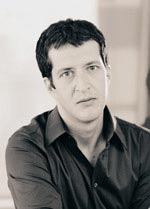Ariana Ghez
Photo Rochester Philharmonic Orchestra |
One of the things I love about performance is that for every play or concert that I look forward to that turns out to be a dud, there is another show that turns out to be an unexpected surprise. Tonight’s LA Phil-sponsored chamber music program was just one of those shows. An odd grouping of 20th century works, the program seemed to focus on three individuals: the composer Steven Stucky, the composer and pianist Thomas Adès, and the Philharmonic’s new principal oboist Ariana Ghez. While these figures certainly played leading roles, all of the performances were so strong and the music so affecting that the show became much greater than the sum of its parts.
First was Françaix’s
Trio for Oboe, Bassoon, and Piano that was clearly a platform to highlight the talent of the new principal oboist the Phil recently hired, Ariana Ghez. Ms. Ghez’s appointment was remarkable for her young age, but hearing her play tonight made it clear how this all came to pass. I’m as far from an expert on oboe technique as you can get, but the showcase seemed to come off without a hitch. Her playing was magnificent and she is quite a striking figure with her large mane of hair.
Next up was Stucky’s
Nell’ombra, nella luce which held the audience completely rapt in complete silence throughout - a rarity in the WDCH acoustic chamber. Closing out the program was Fauré’s
Piano Quintet No. 2 in C minor featuring Thomas Adès on piano. Adès was great, not just because of his playing or insight into the music, but more so because he was able to actually listen to the other musicians and interact with them as a whole unit.
Thomas Adès |
I have seen other visiting stars in recent years, including the likes of Joshua Bell ,come in and roll over everyone in these small groups often at the expense of the music itself. It was nice to see someone who could integrate easily to turn in a stunning performance with the whole team, including
Dale Hikawa Silverman,
Johnny Lee,
Ingrid Chun, and
Brent Samuel.
The other interesting thing about this evening was observing one of those moments that says everything about the differences between American and European audiences and the implications of public funding for the arts. Before the performance, two young men were lurking around the front orchestra looking to snag unoccupied seats closer to the stage. At the intermission, saavy ushers caught them and confronted them about having moved into spaces they apparently hadn't paid for. Despite empty seats throughout the hall, both men retreated farther back in the theater after some low-level argument about the matter. This was a stark contrast to the situation at the Berlin Philharmoniker earlier this year in which we observed the ushers actually assisting comparable young men in achieving the same goal. I tend to think this says a lot about the way American’s think of everything in terms of ownership and getting only what you’ve earned or paid for yourself. On the other hand, in Berlin, it was more about the performance and the space being a public good that everyone has contributed to and can participate in. Less public money results in more policing of all the private dollars and what they have been used to purchase, including maintaining empty seats on principal.
I could go on, but I won’t since there is a much better and broader discussion of some of these issues on
Sandow’s site. If you haven't already, you should take a look at some of the interesting posts he has published recently about the history of funding of orchestral groups in the US.








Follow Along
Brian
Los Angeles
Follow me on Twitter